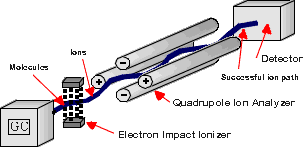


A mass spectrometer produces ions (charged particles) from chemical substances and then uses electric and/or magnetic fields to measure the mass (or weight) of the ions. Using the mass and relative abundance of ions in a mass spectrum, scientists can determine the molecule’s structure and elemental composition.
There are several different types of mass spectrometers: time-of-flight, neutral, and ion, to name a few. The mass spectrometer on the Huygens probe is a quadrupole mass spectrometer. Scientists chose to build a quadrupole mass spectrometer because it could withstand the extreme temperatures of space and the harsh vibrations experienced during the spacecraft launch.
All mass spectrometers, regardless of their specific type, have three basic parts. Below is a schematic of a quadrupole mass spectrometer:

Mass spectrometer image courtesy of University of Arizona, Department of Chemistry